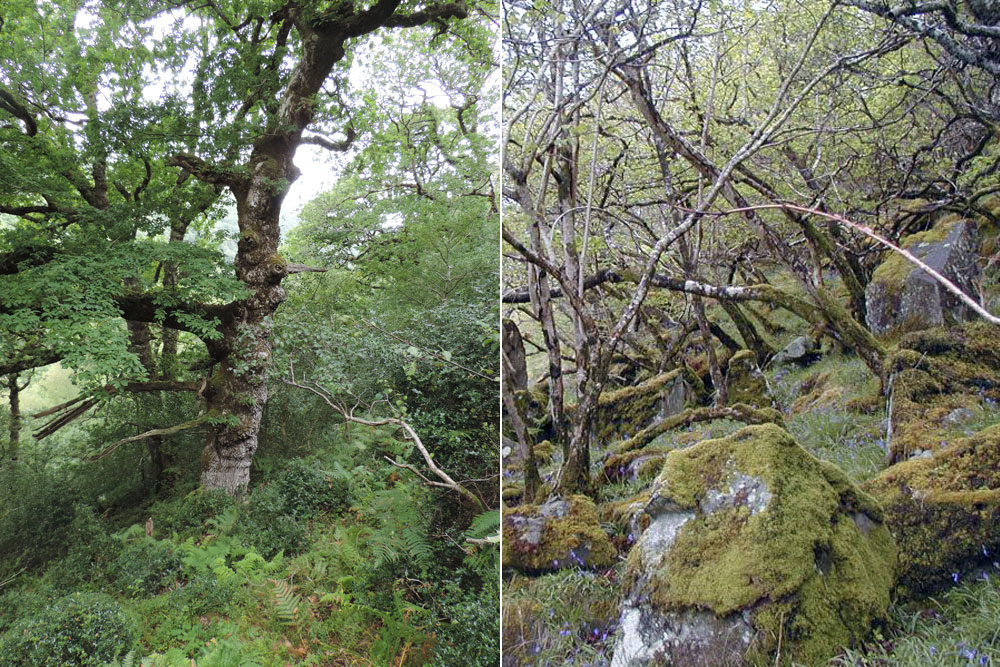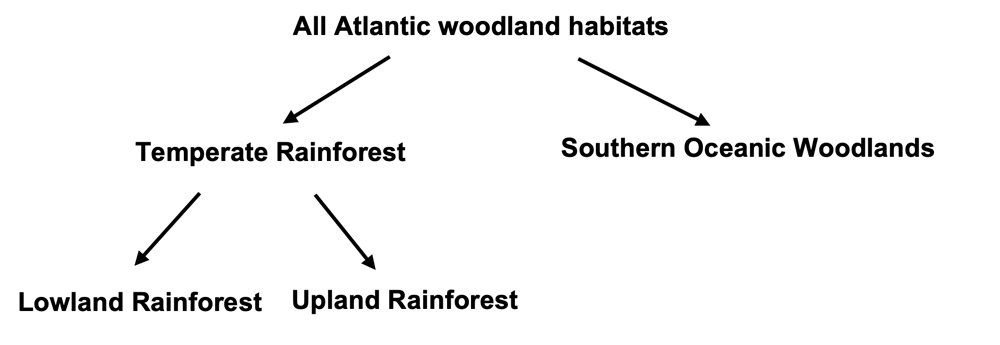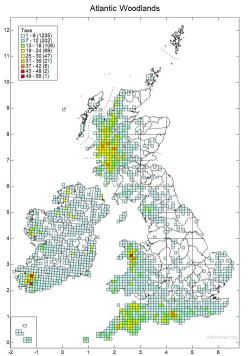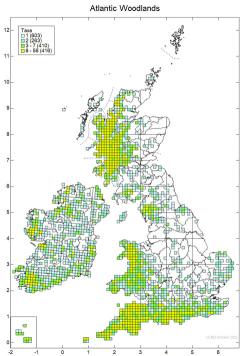
Information Note: Atlantic Woodlands in Britain & Ireland.
Temperate Rainforests and Southern Oceanic Woodlands.
Introduction
The western seaboard of Britain and Ireland supports a network of internationally important woodlands, recognised as Atlantic woodlands. These are typically old-growth woodlands, in clean-air situations, that are strongly influenced by oceanic (wet & mild, with equable annual temperatures) to pluvial hyper-oceanic (very wet & mild, with equable annual temperatures) climates. As a result, these woodlands support suites of biodiversity, where the most distinctive features are their lichens and bryophytes (mosses and liverworts). These woods are also rich in ferns, including the characteristic filmy ferns, but otherwise lack distinctive flowering plants, tree species or general fauna to distinguish them from woods to the east.
The recent interest in Atlantic woodlands is very much welcomed, particularly the increased national profile of “Temperate Rainforests” and their associated “rainforest” biodiversity, which is especially gratifying. However, large geographical areas currently referred to as temperate ‘rainforest’ areas have woodlands that are not strictly “rainforests” but can still support ‘old growth’ and oceanic lichen and bryophyte assemblages of international importance. To aid understanding of Atlantic woodland habitats and ensure their conservation, as a starting point this document summarises and classifies Atlantic woodland types within Britain and Ireland.
Atlantic Woodland Classification
Atlantic woodlands are categorised into two internationally important woodland types, which include Temperate Rainforests and Southern Oceanic Woodlands (Coppins & Coppins 2002, Ellis 2016 & Sanderson et al. 2018). These habitats are of European and international importance; along with Blanket Bogs and Atlantic Wet Heaths, some of the few habitats which have their strongest development in Britain and Ireland. The conservation of Atlantic woodlands should prioritise the conservation of both Temperate Rainforests and Southern Oceanic Woodlands.

All Atlantic woodland habitats: the oceanic climates of Britain and Ireland, with their mild winters and generally damp conditions are favourable for distinctive suites of lichens and bryophytes, which are otherwise rare in a European and/or global context. For lichens, the genera and even species involved often have distributions centred around the wet tropics and moist warm temperate zones. In general, slow colonising lichen and bryophyte species require undisturbed environments and occupy very narrow ecological niches. Lichens in particular require continuity (e.g. veteran trees and bushes), within sheltered but well-lit habitats, with a ground flora / understory that is open and relatively clear of invasive native species (e.g. bramble and dense thickets of holly). Ideal conditions are found in sustainably grazed old-growth woodlands, grazed by either managed domestic or wild herbivores. The best sites have a long continuity back into the deep past. Woodlands of recent or planted origin are invariably species poor and hundreds of years are required for full recovery. Maps 4 & 5 give an indication of the possible extent of Atlantic woodland habitats as determined by the lichens.
Atlantic woodlands are categorised into two internationally important woodland types, which include Temperate Rainforests and Southern Oceanic Woodlands (Coppins & Coppins 2002, Ellis 2016 & Sanderson et al. 2018), where these habitat types are outlined below.
- Temperate Rainforest: these woodland types occur in very wet areas which do not dry out in summer i.e. there is no significant summer water deficit, which requires cool and cloudy summers. The climatic features of rainforest habitats are well summarised in Averis (2022). These can be divided into low-lying Lowland Rainforest found near the coast and higher inland woods, Upland Rainforest. The latter can occur in close association with Lowland Rainforest near the coasts but can extend inland where they occur as cloud forests, in an altitudinal band above other forest types (Sanderson, 2022). The distribution of well-developed Temperate Rainforest and the occurrence Blanket Bog within the forest zone match closely in the west (further east the Blanket Bog is mainly found above the temperate forest zone). Two main types of rainforest can be defined by their lichen assemblages:
Lowland Rainforest: low-altitude temperate woodland, where the richest woods are on less acidic soils supporting species such as Hazel and Ash. These occur in very wet areas with no summer water deficit and can only develop fully where highly dissected mountains are close to the sea (especially in fiord landscapes). The western Highlands and the mountains of south west Munster provide the best habitats in Britain and Ireland by far, but smaller pockets occur in other areas, with North Wales, The Burren and Galway especially notable (Map 1). To the south where winters are still wet, but summers are distinctly drier and warmer, the Lowland Rainforests are replaced by Southern Oceanic Woodlands, where both of these woodland types are exceptionally rich in species of European importance with many leafy species shared, but a much more distinct assemblages of crust forming species.
Lowland Rainforests and Southern Oceanic Woods can share many old growth and oceanic leafy lichen species, but those oceanic species are often best developed in Lowland Rainforests where the communities are more diverse as they include additional hyperoceanic species. However, these woodland types have markedly different assemblages of crust forming lichen species. Southern Oceanic Woods support ‘old growth’ crustose communities on a variety of bark textures, including distinctive smooth bark species and old growth assemblages on the rough bark of veteran trees, where these are not found in ‘rainforests’ (where it is generally too wet for them). Smooth bark in true Lowland Rainforests (especially on hazel, but also other species such as rowan) have a very distinctive assemblage of hyperoceanic species that are not seen in Southern Oceanic Woods (where it is generally not humid enough in summer for them).
- Upland Rainforest: this temperate woodland also occurs in very wet areas with no summer water deficit, but on more acid soils with Oak, Birch and, in Scotland, Pine generally dominant and grade towards boreal woodland as a habitat. Whereas Lowland rainforest are more confined to sheltered areas, Upland rainforests can tolerate more exposed conditions and extend much higher up into the hills. They can also occur further inland than lowland rainforest, occurring as ‘cloud forests’. As a result, this rainforest type is thus much more extensive being found on higher ground beyond the hotspots for Lowland Rainforest, as far south as the moors of south west England and east in Ireland to the Wicklow Mountains (Map 2). In general, the Upland Rainforest is less spectacularly species-rich than both lowland Atlantic woodland types.
Southern Oceanic Woodland: found in oceanic areas which are wet in winter but have significant negative summer water deficits i.e. it still rains in summer but warmer temperatures mean that there is an excess of evaporation over rainfall in summer. For lichens (but not necessarily bryophytes) this is a very good habitat for tropical – warm temperate lichens, where this habitat is especially important for genera of Trentepohlia algae containing lichens which have their highest diversity in the humid tropics (Wolseley et al, 2016).
The climate envelope for this habitat is probably quite wide, but much of it covers intensively used land that lacks old growth woodlands. The richest areas are found in southern England, from the New Forest to central Cornwall, along with North Wales and mountains of south west Munster. In the more upland areas with high rainfall (e.g. Dartmoor) the southern oceanic assemblage overlaps with the Upland Rainforest areas In North Wales and south west Munster, the southern oceanic assemblage overlaps with the rainforest assemblages. There are also scattered rich woods elsewhere, very thinly throughout the rest of Ireland and also locally western England north to the Lake District and in Wales (Map 3). To the north, where winters are still wet, but summers are distinctly wetter and cooler, the Southern Oceanic Woodlands are replaced by Lowland Rainforests.
Conclusion
The Atlantic woodlands in Britain include three distinct woodland types including Southern Oceanic Woods, Lowland Rainforests and Upland Rainforests. All habitats are of international importance and require appropriate conservation management. Current ‘rainforest’ thinking regards all three types as rainforests, overlooking the fact that the southern oceanic woods support unique and important assemblages that are absent from true rainforest biomes, and are too dry in summer to support most of the hyperoceanic ‘rainforest’ species. Recognition of the importance of all these assemblages is desirable and will hopefully help secure appropriate management for both the rainforest and southern oceanic assemblages.
References
Averis, B. (2022) A provisional definition of temperatre rainforest in Britain and Ireland. Unpublished document, the current version (2023) can be accessed here.
Ellis, C.J. (2016) Oceanic and temperate rainforest climates and their epiphyte indicators in Britain. Ecological Indicators 70 (2016) 125–133.
Coppins, A.M., Coppins, B.J., 2002. Indices of Ecological Continuity for Woodland Epiphytic Lichen Habitats in the British Isles. British Lichen Society, London.
Sanderson, N. A. (2020) Lichen Survey of Rydal Park, Westmorland, 2019. A British Lichen Society report to Plantlife
Sanderson, N. A. Wilkins, T., Bosanquet, S. & Genney, D. (2018) Guidelines for the Selection of Biological SSSIs. Part 2: Detailed Guidelines for Habitats and Species Groups. Chapter 13 Lichens and associated microfungi. Joint Nature Conservation Committee 2018: Peterborough, download link.
Wolseley, P., Sanderson, N. A., Thüs, H., Carpenter, D. & Eggleton, P. (2016) Patterns and drivers of lichen species composition in a NW-European lowland deciduous woodland complex. Biodiversity Conservation DOI 10.1007/s10531-016-1250-3
Publishing Information
This document has been compiled by Neil Sanderson, April Windle and Andy Acton and approved by the Conservation Committee of the British Lichen Society, 27/2/2022. Cite as
Sanderson, Windle, A. & Acton, A. (2022) BLS Information Note: Atlantic Woodlands in Britain & Ireland - Temperate Rainforests & Southern Oceanic Woodlands. Access: link.
Annex 1: Lichen Coincidence Maps
Click on the maps for larger versions of the maps
Map 1 Lowland Rainforest | Map 2 Upland Rainforest |
Map 3 Southern Oceanic Woodland | Map 4 Atlantic Woodland: lichen hot spots |
Map 5 Atlantic Woodland: potential extent of |
|
(Numbers in boxes = numbers of species recorded per 10km national grid square)
Species Used in Coincidence Maps
The species were chosen by Neil Sanderson based on the lists used to define the areas of application of the new woodland indices (Sanderson, in press), but with the Southern Oceanic Woodland list trimmed to species more restricted to the core area of high interest, as opposed to the more sub-oceanic areas also covered by the SOWI index. The species chosen are species that are those that have their main areas of distribution within the habitat concerned or are confined to it. Very rare species have been excluded as giving limited information. Maps 4 & 5 use all these species to give an idea of the extent of Atlantic Woodland habitat as determined by the characteristic lichens.
| Map 1 Lowland Rainforest Arthonia ilicinella Arthopyrenia carneobrunneola Arthopyrenia nitescens Arthothelium macounii Arthothelium lirellans Bactrospora homalotropa Crutarndina petractoides Fissurina alboscripta (Graphis alboscripta) Fuscopannaria sampaiana Gabura fascicularis (Collema fasciculare) Gomphillus calycioides Leptogidium dendriscum (Polychidium dendriscum) Leptogium brebissonii Leptogium burgessii Leptogium cochleatum Leptogium hibernicum Parmeliella testacea Pseudocyphellaria citrina (Pseudocyphellaria crocata) Pseudocyphellaria norvegica Pyrenula hibernica Stenocybe nitida Thelotrema macrosporum | Map 2 Upland Rainforest Calicium lenticulare Cetrelia olivetorum s. lat. Graphina pauciloculata Graphina ruiziana Hypotrachyna endochlora Hypotrachyna laevigata Hypotrachyna sinuosa Hypotrachyna taylorensis Lecanora alboflavida Menegazzia terebrata Micarea alabastrites Micarea stipitata Parmelinopsis horrescens Pertusaria ophthalmiza |
| Map 3 Southern Oceanic Woodland Agonimia allobata Agonimia octospora Arthonia invadens Cresponea premnea Coenogonium confusum (i.e. Porina rosei s. lat.) Syncesia myrticola m. sorediata (Enterographa sorediata) Inoderma subabietinum Lecanographa lyncea Micarea pycnidiophora Mycoporum lacteum Opegrapha fumosa Parmelinopsis horrescens Parmelinopsis minarum Phaeographis dendritica Phaeographis inusta Phaeographis lyellii Phyllopsora rosei Porina coralloidea Porina hibernica Rinodina isidioides Schizotrema quercicola (Schismatomma quercicola) Snippocia nivea (Schismatomma niveum) Synarthonia astroidestera (Arthonia astroidestera) Syncesia myrticola m. sorediata (Enterographa sorediata) Thelopsis corticola (Opegrapha corticola) Thelopsis rubella Wadeana dendrographa Usnea ceratina Usnea florida Varicellaria velata | |
_0.jpg)
_0.jpg)
_1.jpg)

